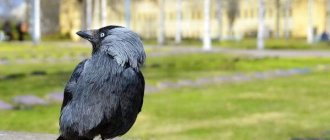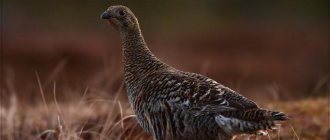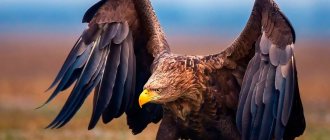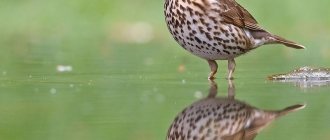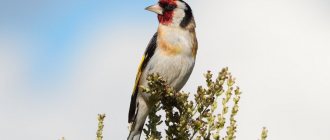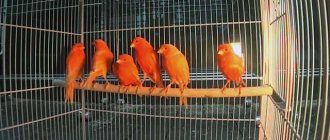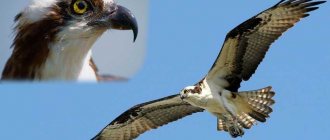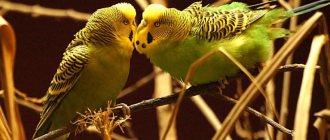Description of the bird
Starling songbirds belong to the Starling family of the order Passeriformes. They not only sing melodiously and are distinguished by the abilities of mockingbirds, but also destroy insects, for which they are loved in all corners of our planet where they were brought by humans.
There are about 10 species of starlings, which differ mainly in the regions of their residence. The most famous of them is the common starling, a resident of Eurasia.
— Advertising —
Starlings are thrush-sized birds with a long, straight beak with a slightly flattened tip, a short tail and sharp wings. Their plumage is predominantly black with white patches and a characteristic multi-colored tint.
Other types of starlings
In our country, the common starling can be seen almost everywhere in open areas. In the Far East you can find a close relative of the common starling – the gray starling. These flocking birds live in large communities.
In the southern regions of the country there is a pink starling, which differs from the ordinary one in color. Only the head, wings and tail are colored black, while the rest of the feathers are pink. These birds settle in the Black Sea steppes, Altai and Caspian Sea. The value of these starlings lies in their ability to feed on locusts. Each bird is capable of destroying up to 200 g of pests daily. The pink species also feeds locust chicks after tearing off the wings and legs from the insect.
All species of these birds love to feast on garden fruit trees and shrubs: cherries, strawberries, mulberries and others. They swallow the berries whole, causing significant damage to gardeners. For this, many summer residents do not like these birds.
What does it eat?
Starlings are omnivorous birds that find their food depending on the time of year.
In spring, they prefer animal food - earthworms, insects and arthropods (spiders, caterpillars, butterflies, grasshoppers). In summer and autumn, they willingly eat plant food: fruits, vegetables, berries, seeds.
— Advertising —
Starlings can use their large and strong beak as a kind of lever to open fruits protected by a hard peel or shell.
Habitat and distribution area
The distribution range of starlings is very wide. Each species has its own characteristics in distribution, and in general, the natural habitats of these birds include all regions of Europe and Asia, as well as North Africa.
Certain species of starlings were brought by humans to North and South America, Australia and New Zealand. The spread of starlings was facilitated primarily by their reputation as excellent pest fighters.
Starlings inhabit the plains and rarely climb the mountains. They willingly choose housing close to a person.
Is the starling a migratory bird?
The starling's migration directly depends on its habitat. All birds living in the northern regions migrate south for the winter and are considered migratory birds. Their migration begins in September-October, and the distance that starlings travel reaches 2,000 km. Birds return to their native lands at the end of March or in April.
Starlings, which live in southern Europe and Asia and Africa, are sedentary birds.
How do starlings live?
The most difficult life is for migratory starlings, who return to their homeland in April with the onset of warming. It happens that snow falls this month, which drives the birds further south. Individuals that do not have time to migrate simply die.
Males are the first to return to their homeland . Females arrive a little later, when their chosen ones have already chosen nesting sites. Birds willingly settle in birdhouses and hollows. Here they begin to hone their vocal abilities and do not forget to fight with their neighbors.
Males stretch their heads upward, open their beaks wide and flutter their wings. It is not always possible to hear harmonious sounds from their throats: birds often squeal and squeal unpleasantly. It happens that starlings imitate the voice of some subtropical bird, but most often they imitate the following birds:
- Orioles;
- Lark;
- Jays;
- Drozdam;
- reeds;
- Quails;
- Bluethroats;
- Swallows;
- Roosters and hens;
- Ducks and many others.
As mentioned earlier, starlings can imitate not only birds, but also other animals and even objects. They can imitate the bark of a dog, the meow of a cat, the croaking of a frog, the creaking of a cart and the clatter of a typewriter.
Common starlings are not particularly friendly birds . They quickly get into fights with other birds if a good nesting site is at stake. For example, once in the USA, starlings drove red-headed woodpeckers from their homes. In Europe, these birds constantly fight with green woodpeckers and rollers.
Starlings are very sociable individuals, so they always group in flocks and settle in nearby colonies. They also fly in groups of several thousand birds, which soar synchronously, turn and come in to land.
Birds also spend the night in groups, most often on tree branches. At wintering grounds, a flock of nocturnal birds can reach several million individuals.
Migration of starlings
The further north or east starlings live , the more likely it is that the birds will have to immigrate. For example, almost all the inhabitants of England and Ireland fly south. Half of the starlings immigrate from Belgium. 1/5 of the birds living in Holland spend the winter here, the rest go to winter 500 km to the south - most often to Belgium and Northern France.
The first batch of starlings, as a rule, goes south in early autumn after the autumn moult has completed. The peak of migration occurs in mid-autumn and ends by November. Single individuals immigrate the fastest. They start at the beginning of July.
As for the Czech Republic, Germany and Slovakia , here only 8% of birds fly south for the winter. In Switzerland, this figure is even lower and is only 2%.
Starlings, which live in eastern Poland, northern Scandinavia, northern Ukraine and Russia, are migratory. They usually winter in southern Europe, India or northwestern Africa. When migrating, these birds cover a distance of 1-2 thousand kilometers.
Some birds return back very early - in February or March, when the ground is still covered with snow. At the end of April - beginning of May, those who live in the northern regions fly home.
Lifespan
The average lifespan of these birds is documented. These data were provided by ornithologists Anatoly Shapoval and Vladimir Paevsky, who studied starlings in the Kaliningrad region at one of the biological stations. According to these data, the average life expectancy of common starlings is 12 years .
What do starlings eat?
This life expectancy is explained by the omnivorous nature of birds . Birds eat both plant-based (they love spak) and protein-rich food, which consists of:
- Earthworms;
- Snails;
- Insect larvae;
- Grasshoppers;
- Caterpillars;
- Butterflies;
- Symphil;
- Spiders.
A flock of starlings can destroy entire grain fields and vineyards. They cause considerable damage to summer residents by eating berries in gardens, as well as fruits or seeds from fruit trees.
Reproduction
Starlings that winter in their homeland begin mating with the onset of spring , and migrating starlings begin mating immediately after arrival. The duration of the mating season depends on weather conditions and the availability of food.
Pairs make nests in birdhouses or tree hollows, as well as in the foundations of larger birds’ homes. When the starling has chosen a place, he attracts the female with his singing.
Both the male and the female arrange the nest , looking for stems, roots, twigs, foliage, animal fur and bird feathers. Starlings are polygamous individuals; they can charm several females at once. There are usually 4-7 eggs in a clutch. The incubation period lasts almost 2 weeks. At this time, the male can sometimes replace the female, who constantly sits on the eggs.
You can find out that chicks have been born by looking at the shell under the nest. The chicks' parents hardly rest. In the morning and evening they look for food for their offspring. In order to find food for the chicks, parents leave several dozen times a day.
At first, the diet consists only of soft food. A little later, grasshoppers, caterpillars, beetles or snails are used. After 3 weeks, the chicks can fly out of the nest on their own.
Kinds
Common starling
The bird is up to 22 cm in length with a wingspan of about 38 cm and weighs 70-80 g. The long and sharp beak is slightly curved downwards. The color of the back and belly of females and males is no different: black plumage with a metallic sheen of purple, green, blue or brown. The species is distributed throughout Eurasia.
Brahmin Starling
The species lives in southern Asia. This is a bird 20 cm in length, with a wingspan of up to 12 cm and weighing about 50 g. The back of the bird is brownish-gray, the breast and belly are beige-brown. The head is decorated with shimmering black feathers that form a crest. The beak is yellow. Sometimes the Brahminy Starling is confused with the Pink Starling, but it differs in that it does not have black feathers on its chest.
Cambodian starling
The body length of birds is up to 25 cm. The plumage of the head, neck and chest is light brown. The belly is pink-gray. The back is dark gray, sometimes with a slight metallic tint. The species lives in the countries of Indochina, including Myanmar, Thailand, Vietnam, Laos, and Cambodia.
Red-billed Starling
Lives in the south and west of China. It reaches 20-24 cm in length. Males have a white head and abdomen with a brown or gray tint. The chest, back and sides are dark gray. The plumage of the tail and wings is black with a green, blue or purple metallic tint. The beak, according to the name, of this species is red.
Piebald starling
The main habitat of this species is south and southeast Asia. The bird is similar to the black-necked starling, but smaller in size. The male and female are very similar. The plumage of their head, throat, chest and back is black. The cheeks and lower body are white and gray. The wings and tail are brown-black with white feathers. The beak is orange-red.
Pastor
The species reaches a length of 22 cm, a wingspan of up to 14 cm, a weight of 60-90 g. It is distinguished by its contrasting unusual plumage: black with a metallic sheen on the head, neck and chest and pastel pink abdomen and back. On the head there is a crest of long feathers. The beak is thicker and shorter compared to the common starling. The pink starling lives in southeastern Europe and Central Asia.
Grey-headed Starling
This relatively small species lives in India and China. The body length reaches 22 cm, weight - 45 g. The bird's head is white-gray, the cheeks and back of the head have a silvery tint. The beak is interesting: blue base, green middle and yellow tip. The back is brown-gray, the belly is brown.
gray starling
A songbird with a body length of up to 25 cm. Resident of East Asia. The breast, abdomen and rump of this species are light gray in color. The feathers on the head are streaked with black and black-brown; there are tufts of white feathers on the cheeks. The beak is yellow-orange with a dark tip.
Black-winged Starling
The species lives on the islands of Java and Bali in Indonesia. Its body length is 22-24 cm, its wingspan is up to 130 cm. The color of the plumage of this species is mainly white, except for black wings and a tail with a white stripe at the end. The feathers on the head are brown in color and form a crest at the back of the head. The beak and legs are yellow.
Black-necked Starling
One of the largest representatives of the starling species with a body length of up to 30 cm and a wingspan of up to 16 cm. Distributed in southeast China, Myanmar, Thailand, Laos, Cambodia and Vietnam. The back, tail and wings are black with white patches, the head and belly are white. On the neck there is a collar of black shiny feathers.
Black starling
Inhabitant of Europe and North Africa. Bird dimensions: 19-22 cm in length, 13-14 cm wingspan, 80-115 g weight. The species is very similar to the common starling. The predominant color of its plumage is black with a metallic tint of purple or green. The tail is short and straight. The beak is sharp and long, curved downwards.
Description of the appearance of the starling bird
The birds weigh only about 75 grams, their body length reaches 18-22 cm, and their wingspan is 39 cm. Externally, starlings differ:
- Black with a metallic sheen, which molts and turns brown in the spring. Some subspecies of birds may have bronze, purple, greenish or bluish feathers.
- Long and sharp beak slightly curved downwards. He, like a chameleon, can change color during the mating season from black to yellow.
- Brown-red, large and strong paws with curved claws.
- Massive body.
- Short neck.
- Short tail.
By looking closely at the starling's plumage, you can distinguish a female from a male . The male has lilac speckles on its beak, while the female has red spots. The male has elongated feathers on the chest part of the body, while the female has short feathers.
Types of starlings
In addition to the common starling described above, there are several more species of this songbird in nature.
Pastor. The name of the bird is associated with its color. When a flock of these starlings flies, from afar it seems as if a pink cloud is moving in the sky. Since individuals of this species feed mainly on locusts, they settle near semi-desert and desert plains and steppes. If there are no locusts, then they have to be content with other insects.
And yet, pink starlings try to find locusts, for which they fly long distances . During the day, one bird eats about two hundred grams of insects, which is twice the weight of the starling itself.
Birds make nests between stones, in various burrows, and in rock crevices. This bird species is peaceful, so you won't see them quarreling or fighting.
Catkin starling. The bird, which lives only in Africa, got its name from the fleshy growths resembling earrings that form on the head of males during the breeding season. Birds build nests not in hollows, but on tree branches. create a dome-shaped structure from dry twigs . Since starlings live in flocks, there can be several dozen of these “houses” on one tree.
Catkin starlings feed only on locusts. Therefore, chicks are hatched only at a time when insects stop near the nests for breeding. As soon as the locusts move from their place, the entire flock follows them.
Male and female: main differences
Sexual dimorphism in all starling species is rather weakly expressed. So, for example, the male and female common starling differ in the feathers on their chest - in females they are more graceful and shorter. In addition, females have red dots at the base of the beak, while males have a blue spot.
In other species, females and young are slightly lighter than male starlings.
Reproduction
The mating season usually begins in early spring, and in the case of migration, soon after arrival. In the northern hemisphere, this period occurs at the end of March - beginning of July, and in the southern hemisphere, in September - December. The length of the season can vary and depends on weather conditions and the availability of food supply. In European and Asian populations there are usually three stages of reproduction per season, each of which ends in the laying of eggs[4][9]. The first clutch, containing 4-6 (less often 7) eggs, begins in all surrounding birds simultaneously, soon after the start of the breeding season. The second clutch is associated with the natural polygyny of starlings. The third clutch, like the first, is synchronized throughout the population and occurs 40-50 days after the start of the first [4] [9].
Clutch of eggs of the common starling
In the spring, the males are the first to arrive at the site, and they immediately begin to look for a place for a future nest - a hollow, a hole in the wall of a house, or a birdhouse. Sometimes the nest is made at the base of the nests of birds of prey, such as the white-tailed eagle ( Haliaeetus albicilla
), or herons[15]. Having chosen a good place, they sit nearby and begin to sing, signaling to other males that the place is occupied and attracting females. The females arrive a few days later, and after a short time the formed pairs begin to build a nest. Dry tree branches, roots, stems, leaves, wool and feathers of other birds are used as bedding. Both future parents build the nest. A male can court either one female or several at the same time (simultaneous polygyny). In addition, they are able to fertilize first one female, and after some time the second (sequential polygyny). According to studies conducted in Belgium, from 20 to 60% of males were polygynous, and similar tests in Frankfurt am Main in Germany showed at least 50% of males were polygynous[16]. Usually the clutch consists of 4-6 (less often 7) light blue eggs without specks[3][10][13]. The average size of the eggs is 31 mm in length and 21 mm in width, weight 6.6 g. The female incubates mainly, the male only occasionally replaces her for a while. The incubation period is 11-13 days[16].
The chicks appear helpless and in the first days behave silently so that their existence can be recognized only by the shell thrown out of the nest. Both the male and the female are engaged in obtaining food for the chicks, and they fly away at the same time in search of it, leaving the chicks alone in the nest. Absentations for food mainly occur in the morning and evening hours, and during the day their number can reach several dozen [15]. At first, parents feed the chicks with soft food, but as they grow, they also bring them tougher insects: grasshoppers, beetles, large caterpillars and snails. Grown-up chicks are able to leave the nest 21-23 days after hatching, but are fed by their parents for another day or two. To lure frightened chicks out of the nest, parents resort to all sorts of tricks: for example, they roll around with food in their beaks near the nest, luring them out[15].
Keeping at home
In captivity, a starling will need a cage with a minimum size of 70 cm by 30 cm by 45 cm with a separate container for bathing and drinking, as these birds love to swim. The water is changed daily.
What to feed
Birds are absolutely unpretentious in nutrition. The diet is often based on a nightingale mixture of grated carrots, eggs and white crackers. They also add fish food (daphnia, gammarus), meat (pieces of chicken or beef), plant and grain seeds, vegetables (everything except legumes and potatoes), herbs, pieces of fruit and berries.
The only downside to keeping these birds is their sloppiness. Starlings are truly dirty, you need to clean up after them often.
Interesting Facts
- In nature, starlings live up to 12 years, and in captivity - even up to 20 years;
- Starlings are very aggressive towards other bird species, and can displace species from their usual habitats, as, for example, happened in North America during the conflict between the starling and the green woodpecker;
- Starlings are known as pest fighters, but they can also cause harm to humans - destroy crops of grain plants and vineyards;
- Starlings like to live in large flocks; during migration, several thousand individuals can gather together for the night.
- The synchronized migration of large flocks of starlings is called murmuration. This is a very beautiful and fascinating phenomenon - many birds seem to dance in the air, forming various intricate figures that decrease and increase in the sky. Murmuration remains a mystery in bird behavior for scientists today. This process cannot be reproduced even with the most modern technology.
Starling
- home
- Articles
- Encyclopedia of Animal Species
- Wild birds
- Starling
- Content
- Common starling—Sturnus vulgaris
- Appearance
- Spreading
- Lifestyle
- Reproduction
- Nutrition
- Taxonomy
- Ecology and human interaction
- Sources and materials
Our country is home to 6 species of starlings belonging to 4 genera. The most famous of them is the common starling, or shpak. It inhabits mainly the zone of broad-leaved and mixed forests of Europe and Western Asia east to Lake Baikal. But most often it can be found in the cultural landscape. Thanks to humans, the starling's range is expanding. And not only on those continents where it has lived since ancient times, but also spreads to new continents: in North America, where it has become a numerous bird, in Australia, South Africa, New Zealand and on many other oceanic islands, where it has never been.
Common starling—Sturnus vulgaris Kingdom: Animalia Phylum: Chordata Class: Birds Subclass: New palates Order: Passeriformes Suborder: Song passerines Family: Starlings Genus: Starlings Species: Common starling
Appearance A small bird with a length of 18.7-21.2 cm, a wingspan of about 38.7 cm and a weight of 75 g. The body is massive, with a short neck. The beak is long, sharp and slightly curved downwards; During the breeding season it is yellow, the rest of the time it is black. Unlike blackbirds (Turdus merula), the beak is flattened on the sides and is not as powerful. The iris of the eyes is brown. The wings are short, wide at the base and tapered at the tip. The plumage of the back, chest and back of the neck in females and males of adult birds does not differ from each other: black feathers with a metallic sheen, which in some subspecies can have purple, greenish, bluish or bronze shades. In winter, when the tips of the feathers wear off, numerous white or cream specks appear on the body, larger ones on the chest and outer part of the wings and smaller ones on the head. After the spring molt, the plumage becomes monotonously brown. The tail is short, 6.2-6.8 cm long, almost straight at the end. Legs are reddish brown. Males and females are somewhat different from each other: the males have long breast feathers, while the females have short and graceful feathers; at the base of the beak of males there is a bluish spot, while females have reddish specks in this place. In young birds, the gloss on the body is not so pronounced, and the ends of their wings are rounded, and not sharp, like in adult birds. The beak of grown chicks is brownish-black all year round.
Distribution The common starling is widespread in all biogeographical regions except the Neotropical (Central and South America). In Eurasia it lives over a vast territory: in the north the range is limited by the Kola Peninsula and Iceland, in the south by Northern Spain, Southern France, Italy, Yugoslavia and Northern Greece, Turkey, Northern Iraq, Northern Iran, Afghanistan, Pakistan and North-West India; in the east by Lake Baikal; in the west by the Azores. In Siberia it is found up to 60° north. latitude. It was deliberately introduced by humans into South-West Africa, Australia, New Zealand and North America. In particular, in the second half of the 19th century, several attempts were made to establish this species in the United States. The most famous such attempt was the release of about 100 birds in Central Park in New York in 1890-1891. Although only 15 of these birds ultimately survived, they subsequently spread widely across the continent from Southern Canada in the north to Florida and Northern Mexico in the south. It is quite tolerant in its choice of habitat, but is found only on the plain, not climbing high into the mountains. It gets along well in populated areas and in rural areas near farms. Lives in coastal areas, swamps, salt marshes, open forests, steppes, but avoids places that are difficult for humans to reach. During breeding, it requires tree hollows or building niches for nest construction and sown fields as feeding territory.
Lifestyle Has a wide range of sounds, which may include whistles, squeaks, meows, various noises and rattles[5][10]. It is able to imitate the songs of other birds: for example, on the North American continent, it easily adopts the sounds of the Virginia partridge (Colinis virginianus), the noisy plover (Charadrius vociferus), the eastern woodland peewee (Contopus virens) or the eastern meadow quail (Sturnella magna). Russian ornithologists have noticed that starlings are able to imitate thrushes, warblers (Acrocephalus), bluethroats (Luscinia svecica), larks, orioles (Oriolus oriolus), swallows, quails, jays and other birds and even croak like frogs. Sometimes starlings arriving from the south in spring begin to sing with the voices of subtropical birds. In Kazakhstan and Central Asia, starlings imitate the sounds of a flock of sheep, including bleating, barking dogs and the cracking of whips. In one of his stories, the naturalist writer M. Zverev described a starling under his window, which reliably depicted the printing process on a typewriter. In Europe, the degree of migration varies depending on climatic conditions, with the tendency to migrate increasing from west to east and north. For example, in Great Britain and Ireland, birds are largely sedentary; in Belgium, 50-70% of breeding birds remain in the country; About 20% remain in the Netherlands, and the rest winter in England, Belgium and Northern France - around 500 km from the place of birth. In Central Europe, the number of resident birds varies from 2.5% (Switzerland and Southern Germany) to 8% (Eastern Germany, Czech Republic and Slovakia). In northern Scandinavia, eastern Poland, Russia and northern Ukraine, the birds are almost entirely migratory. For migratory birds in Central and Eastern Europe, the distance between nesting sites and winter quarters ranges from 1 to 2 thousand kilometers; During the cold season, most of these birds move to southern Europe, northwestern Africa (Egypt, Algeria or Tunisia) and India. In winter, starlings gathering in large numbers can not only produce an impressive spectacle, but also cause some inconvenience to the local population: for example, during this period, residents of Rome try not to appear on the street in the evening, when the hum of ordinary starlings can drown out even the noise of traffic. When migrating, starlings return to their nesting sites early, when there is still snow. The first birds return in the second half of February, and in Central Europe the bulk arrive by the end of March. In the north of the natural range, migration ends only in early May. Males arrive first, and females appear a few days later. Autumn migration begins in early September after the end of the autumn molt, reaches its peak in mid-October and continues until November. It has been noticed that young non-breeding individuals begin to migrate towards winter quarters earlier than other birds, sometimes as early as the beginning of July. Sometimes in the sky you can observe a large flock of skillfully maneuvering common starlings. Starlings gather in flocks and settle in small colonies, usually several pairs not far from each other. Sometimes they can be seen flying in a huge group of several thousand individuals, while they synchronously repeat turns, parry and land on the ground, scattering over a large area. During incubation and hatching of chicks, they stick to their small territory, which is no more than 10 m in radius, and carefully protect it from other birds. Foraging areas are not protected. They feed away from the nest - on the outskirts of villages, vegetable gardens, cultivated areas and along river banks. Already in mid-June, grown-up chicks behave independently of their parents, forming joint flocks. Starlings also gather in groups to spend the night, usually in coastal areas densely covered with reeds or willows. In addition, at night they can be found in city gardens and parks, sitting on the branches of trees and bushes. In wintering areas, the number of birds spending the night together can reach more than a million individuals. Common starlings are quite aggressive towards other bird species and are able to compete with them for a suitable nesting site. In particular, in the United States, the North American red-headed woodpecker (Melanerpes erythrocephalus), which was forced out of its traditional nesting sites, became a victim of this behavior of starlings. In Europe, starlings successfully compete for the right to occupy a suitable nest site with rollers (Coracias garrulus) and green woodpeckers (Picus virdis). According to Vladimir Paevsky and Anatoly Shapoval (research was carried out at a biological station in the Kaliningrad region of Russia), the life expectancy of common starlings in the wild is up to 12 years.
Reproduction The mating season usually begins in early spring, and in the case of migration, soon after arrival. In the northern hemisphere, this period occurs at the end of March - beginning of July, and in the southern hemisphere, in September - December. The length of the season can vary and depends on weather conditions and the availability of food supply. In European and Asian populations there are usually three breeding stages per season, each of which ends in the laying of eggs. The first clutch, containing 4-6 (less often 7) eggs, begins in all surrounding birds simultaneously, soon after the start of the breeding season. The second clutch is associated with the natural polygyny of starlings. The third clutch, like the first, is synchronized throughout the population and occurs 40-50 days after the start of the first. Laying eggs of the common starling In the spring, the males are the first to arrive at the site, and they immediately begin to look for a place for a future nest - a hollow, a hole in the wall of a house, or a birdhouse. Sometimes the nest is located at the base of the nests of birds of prey, such as the white-tailed eagle (Haliaeetus albicilla), or herons. Having chosen a good place, they sit nearby and begin to sing, signaling to other males that the place is occupied and attracting females. The females arrive a few days later, and after a short time the formed pairs begin to build a nest. Dry tree branches, roots, stems, leaves, wool and feathers of other birds are used as bedding. Both future parents build the nest. A male can court either one female or several at the same time (simultaneous polygyny). In addition, they are able to fertilize first one female, and after some time the second (sequential polygyny). Studies in Belgium found that between 20 and 60% of males were polygynous, and similar tests in Frankfurt am Main in Germany showed at least 50% of males were polygynous. Usually the clutch consists of 4-6 (less often 7) light blue eggs without specks. The average size of the eggs is 31 mm in length and 21 mm in width, weight 6.6 g. The female incubates mainly, the male only occasionally replaces her for a while. The incubation period is 11-13 days. The chicks appear helpless and in the first days behave silently so that their existence can be recognized only by the shell thrown out of the nest. Both the male and the female are engaged in obtaining food for the chicks, and they fly away at the same time in search of it, leaving the chicks alone in the nest. Absentations for food mainly occur in the morning and evening hours, and during the day their number can reach several dozen. At first, parents feed the chicks with soft food, but as they grow, they also bring them tougher insects: grasshoppers, beetles, large caterpillars and snails. Grown-up chicks are able to leave the nest 21-23 days after hatching, but are fed by their parents for another day or two. To lure frightened chicks out of the nest, parents resort to all sorts of tricks: for example, they roll around with food in their beaks near the nest, luring them out.
Diet Starlings are omnivores - they feed on both plant and animal foods. In early spring, they hunt for earthworms that crawl to the surface of the earth in thawed areas or collect insect larvae that have overwintered in secluded places. When warm weather awakens nature, a variety of insects are caught: grasshoppers, spiders, butterflies, caterpillars, Symphila and worms. Plant foods include seeds and fruits of plants: berries, apples, pears, plums, cherries, etc. They can cause serious harm to grain crops and vineyards. If the fruit is protected by a shell or hard skin, they split it using a lever: insert the beak into a small hole and gradually unclench it, revealing the contents.
Taxonomy The taxonomy of the subspecies of the common starling is currently the subject of scientific debate. Subspecies are divided mainly on the basis of different shades of shiny parts of the plumage and slight differences in size. It is often quite difficult to determine by appearance which subspecies a particular bird belongs to. The following list of subspecies is given by Huffer (see Glutz von Blotzheim et al. 1993): S. v. vulgaris: Nominative subspecies. Distributed throughout Europe and east to the Urals. S.v. faroensis: Isolated population in the Faroe Islands. Slightly larger than the nominate subspecies. S.v. zetlandicus: Isolated population in Shetland, Scotland. Intermediate subspecies between S. v. vulgaris and S. v. faroensis. S.v. poltaratskyi: Western and Central Siberia. The crown is pure violet, usually devoid of a greenish tint; the back, rump area and upper tail coverts are green, occasionally with a faint purple tint; throat and upper chest purple; the lower part of the chest is green; the belly is green with a more developed violet tint than in vulgaris; The ear feathers of most individuals are more purple-violet, less green. The lower wing coverts have slightly wider, light buffy edges than those of vulgaris. Close to vulgaris. S.v. tauricus: Two separate populations: southern Ukraine and Crimea, as well as Türkiye. The back is blue-violet, the sides have a bronze tint. S.v. purpurascens: Eastern Black Sea coast, Armenia and northwestern Turkey. Head and neck with copper tint. S.v. caucasicus: North from the Caucasus Range to the Volga, then southwest to the Caspian Sea, south to southwestern Iran. The edges of the elytra and primary wings of the second order are purple. S.v. nobilior: East from the Caspian Sea to Afghanistan. The upper part of the head has a more purple and less green tint compared to S. v. caucasicus. S.v. porphyronotus: Mountains and plains of Central Asia, east to the river basin. Tarim and Pamir. Crown green; the back, rump area and upper tail coverts are violet with a bronze tint; at the northern and southern limits of the distribution of the race, these parts of the plumage have a bluish-greenish or greenish tint; throat and upper chest green; the lower part of the chest is purple; the belly is bronze with a greenish tint; ear feathers usually have a purple tint. The lower wing coverts are gray with whitish edges. S.v. humii: West Himalayas. Head with a blue tint. S.v. minor: Plains of northwestern India. Noticeably smaller than other subspecies.
Ecology and human interaction Humans have a long history of relationships with these birds. To attract them to the destruction of harmful insects in gardens and vegetable gardens, people have long put together artificial houses for them, called birdhouses. When moving to a new place of residence on another continent, people tried to take birds with them. However, the ability to reproduce quickly, coupled with a rather aggressive nature, has made common starlings unwelcome guests in regions where they were not previously found. Starlings can cause the greatest harm to grain crops and berry fields, causing serious economic damage. In western Australia, where starlings have not yet fully settled, the authorities constantly maintain a staff of hunters who shoot these birds. In North America, where in the 19th century, member of the New York Genealogical & Biographical Society Eugene Schieffelin dreamed of inhabiting all the birds sung by Shakespeare, starlings began to threaten the existence of indigenous species, displacing them from their traditional habitats. Excessive populations of rapidly breeding birds have a significant impact on bird biodiversity. Another negative factor is that starlings easily transmit some human diseases, such as blastomycosis, cysticercosis and histoplasmosis. Finally, large flocks of starlings in the vicinity of airports can threaten the safety of air travel.
Sources and materials https://www.ecosystema.ru/08nature/birds/126.php https://ru.wikipedia.org/wiki/%D0%A1%D0%BA%D0%B2%D0%BE%D1 %80%D0%B5%D1%86_%D0%BE%D0%B1%D1%8B%D0%BA%D0%BD%D0%BE%D0%B2%D0%B5%D0%BD%D0%BD %D1%8B%D0%B9 https://www.kalitva.ru/2007/07/21/drevesnye_pticy_coracornithes._skvorcy_sturnidae..html
Health to you and your pets!
© 2021 Team “ZOOVET” We are always happy to help you! 24-hour consultation: +7 Make an appointment [email protected]
Return to list
Singing
Starlings are not only distinguished by their own ringing iridescent trills, which consist of whistling, creaking, hissing sounds, but are also excellent mockingbirds. Perhaps there is no melody that a starling could not reproduce. The song of a thrush, oriole, swallow, lark or jay - the starling can perform any song.
Moreover, the starling can eavesdrop and perfectly copy melodies from the life around him - the croaking of frogs, the barking of dogs, the bleating of sheep.
And at home, a starling can not only be tamed, but also taught to speak short phrases and tongue twisters.

